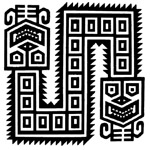Center, Textile Research

PreColumbian Textile Conference VII / Jornadas de Textiles PreColombinos VII (2016)
Date of this Version
11-13-2017
Document Type
Article
Citation
In PreColumbian Textile Conference VII / Jornadas de Textiles PreColombinos VII, ed. Lena Bjerregaard and Ann Peters (Lincoln, NE: Zea Books, 2017), pp. 277–307
doi:10.13014/K2XW4GZ8
Abstract
Las excavaciones arqueológicas efectuadas en Huaca Malena, valle de Asia, costa central del Perú, permitieron recuperar una gran cantidad de finos tejidos del periodo Wari correspondiente a los siglos VII al XI d.C. donde destaca una gran variedad de adornos de cabeza o tocados elaborados en fibra de camélido, cestería y plumas destacando finas bandas constituyendo una extraordinaria muestra de la variedad de tocados existentes durante el Horizonte Medio. Se han identificado 18 tipos de tocados la mayoría asociados al sexo masculino y en menor grado al femenino, algunos de estilos locales y otros probablemente de otras regiones de los Andes. Se describen los tipos identificados.
Tocados from the Middle Horizon to the Late Intermediate on the Central Coast: A View from the Valley of Asia, Peru (7th-12th Centuries AD)
Abstract -- Archaeological excavations carried out at the Huaca Malena site, in the Asia Valley of Peru’s central coast region, permitted recovery of a large quantity of fine textiles of the Wari period, corresponding to the 7th to 11th century AD. A prominent element of the assemblage is a great variety of headdresses created in camelid hair, basketry and featherwork, including fine headbands, which constitute an extraordinary sample of the diverse headdresses that existed during the Middle Horizon. 18 types of headdresses have been identified, the majority associated with men and a smaller number with women, some in local styles and others probably from other regions of the Andes. The types identified are described.
Included in
Art and Materials Conservation Commons, Chicana/o Studies Commons, Fiber, Textile, and Weaving Arts Commons, Indigenous Studies Commons, Latina/o Studies Commons, Museum Studies Commons, Other History of Art, Architecture, and Archaeology Commons, Other Languages, Societies, and Cultures Commons


Comments
Copyright © 2017 by the author